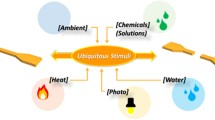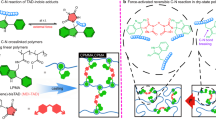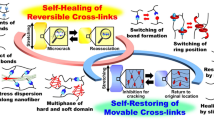Abstract
Even under low external force, a few macromolecules of a polymer have to be much more highly stressed and fractured first due to the inherent heterogeneous microstructure. When the materials keep on working under loading, as is often the case, the minor damages would add up, endangering the safety of use. Here we show an innovative solution based on mechanochemically initiated reversible cascading variation of metal-ligand complexations. Upon loading, crosslinking density of the proof-of-concept metallopolymer networks autonomously increases, and recovers after unloading. Meanwhile, the stress-induced tiny fracture precursors are blocked to grow and then restored. The entire processes reversibly proceed free of manual intervention and catalyst. The proposed molecular-level internal equilibrium prevention mechanisms fundamentally enhance durability of polymers in service.
Similar content being viewed by others
References
White, S. R.; Sottos, N. R.; Geubelle, P. H.; Moore, J. S.; Kessler, M. R.; Sriram, S. R.; Brown, E. N.; Viswanathan, S. Autonomic healing of polymer composites. Nature 2001, 409, 794–797.
Chen, X. X.; Dam, M. A.; Ono, K.; Mal, A.; Shen, H.; Nutt, S. R.; Sheran, K.; Wudl, F. A thermally re-mendable cross-linked polymeric material. Science 2002, 295, 1698–1702.
Chen, X. X.; Zhong, Q. Y.; Wang, S. J.; Wu, Y. S.; Tan, J. D.; Lei, H. X.; Huang, S. Y.; Zhang, Y. F. Progress in dynamic covalent polymers. Acta Polymerica Sinica (in Chinese) 2019, 50, 469–484.
Yin, Q. Y.; Dai, C. H.; Chen, H.; Gou, K.; Guan, H. Z.; Wang, P. H.; Jiang, J. T.; Weng, G. S. Tough double metal-ion cross-linked elastomers with temperature-adaptable self-healing and luminescence properties. Chinese J. Polym. Sci. 2021, DOI: https://doi.org/10.1007/s10118-021-2517-z.
Paulusse, J. M. J.; Sijbesma, R. P. Reversible mechanochemistry of a Pd(II) coordination polymer. Angew. Chem. Int. Ed. 2004, 43, 4460–4462.
Kersey, F. R.; Loveless, D. M.; Craig, S. L. A hybrid polymer gel with controlled rates of cross-link rupture and self-repair. J. R. Soc. Interface 2007, 4, 373–380.
Piermattei, A.; Karthikeyan, S.; Sijbesma, R. P. Activating catalysts with mechanical force. Nat. Chem. 2009, 1, 133–137.
Balkenende, D. W. R.; Coulibaly, S.; Balog, S.; Simon, Y. C.; Fiore, G. L.; Weder, C. Mechanochemistry with metallosupramolecular polymers. J. Am. Chem. Soc. 2014, 136, 10493–10498.
Das, M.; Pal, S.; Naskar, K. Exploring various metal-ligand coordination bond formation in elastomers: mechanical performance and self-healing behavior. Express Polym. Lett. 2020, 14, 860–880.
Wilker, J. J. Marine bioinorganic materials: mussels pumping iron. Curr. Opin. Chem. Biol. 2010, 14, 276–283.
Harrington, M. J.; Masic, A.; Holten-Andersen, N.; Waite, J. H.; Fratzl, P. Iron-clad fibers: a metal-based biological strategy for hard flexible coatings. Science 2010, 328, 216–220.
Zeng, H.; Hwang, D. S.; Israelachvili, J. N.; Waite, J. H. Strong reversible Fe3+-mediated bridging between DOPA-containing protein films in water. Proc. Natl. Acad. Sci. 2010, 107, 12850–12853.
Waite, J. H.; Qin, X. X.; Coyne, K. J. The peculiar collagens of mussel byssus. J. Matrix Biol. 1998, 17, 93–106.
Krauss, S.; Metzger, T. H.; Fratzl, P.; Harrington, M. J. Self-repair of a biological fiber guided by an ordered elastic framework. Biomacromolecules 2013, 14, 1520–1528.
Dzhardimalieva, G. I.; Yadav, B. C.; Singh S.; Uflyand, I. E. Self-healing and shape memory metallopolymers: state-of-the-art and future perspectives. Dalton Trans. 2020, 49, 3042–3087.
Zechel, S.; Hager, M. D.; Priemel, T.; Harrington, M. J. Healing through histidine: bioinspired pathways to self-healing polymers via imidazole-metal coordination. Biomimetics 2019, 4, 20.
Enke, M.; Bode, S.; Vitz, J.; Schacher, F. H.; Harrington, M. J.; Hager, M. D.; Schubert, U. S. Self-healing response in supramolecular polymers based on reversible zinc-histidine interactions. Polymer 2015, 69, 274–282.
Andersen, A.; Chen, Y.; Birkedal, H. Bioinspired metal-polyphenol materials: self-healing and beyond. Biomimetics 2019, 4, 30.
Tunn, I.; Harrington, M. J.; Blank, K. G. Bioinspired histidine-Zn2+ coordination for tuning the mechanical properties of self-healing coiled coil cross-linked hydrogels. Biomimetics 2019, 4, 25.
Filippidi, E.; Cristiani, T. R.; Eisenbach, C. D.; Waite, J. H.; Israelachvili, J. N.; Ahn, K.; Valentine, M. T. Toughening elastomers using mussel-inspired iron-catechol complexes. Science 2017, 358, 502–505.
Mozhdehi, D.; Neal, J. A.; Grindy, S. C.; Cordeau, Y.; Ayala, S.; Holten-Andersen, N.; Guan, Z. Tuning dynamic mechanical response in metallopolymer networks through simultaneous control of structural and temporal properties of the networks. Macromolecules 2016, 49, 6310–6321.
Grindy, S. C.; Learsch, R.; Mozhdehi, D.; Cheng, J.; Barrett, D. G.; Guan, Z.; Messersmith, P. B.; Holten-Andersen, N. Control of hierarchical polymer mechanics with bioinspired metal-coordination dynamics. Nat. Mater. 2015, 14, 1210–1216.
Wang, J.; Liu, C.; Lu, X.; Yin, M. Co-polypeptides of 3,4-dihydroxyphenylalanine and L-lysine to mimic marine adhesive protein. Biomaterials 2007, 28, 3456–3468.
Fullenkamp, D. E.; He, L.; Barrett, D. G.; Burghardt, W. R.; Messersmith, P. B. Mussel-inspired histidine-based transient network metal coordination hydrogels. Macromolecules 2013, 46, 1167–1174.
Andersson, M.; Hedin, J.; Johansson, P.; Nordström, J.; Nydén, M. Coordination of imidazoles by Cu(II) and Zn(II) as studied by NMR relaxometry, EPR, far-FTIR vibrational spectroscopy and Ab initio calculations: effect of methyl substitution. J. Phys. Chem. A 2010, 114, 13146–13153.
Schmidt, S.; Reinecke, A.; Wojcik, F.; Pussak, D.; Hartmann, L.; Harrington, M. J. Metal-mediated molecular self-healing in histidine-rich mussel peptides. Biomacromolecules 2014, 15, 1644–1652.
Li, Y.; Wen, J.; Qin, M.; Cao, Y.; Ma, H.; Wang, W. Single-molecule mechanics of catechol-iron coordination bonds. ACS Biomater. Sci. Eng. 2017, 3, 979–989.
Yang, B.; Lim, C.; Hwang, D. S.; Cha, H. J. Switch of surface adhesion to cohesion by dopa-Fe3+ complexation in response to microenvironment at the mussel plaque/substrate interface. Chem. Mater. 2016, 28, 7982–7989.
Xu, Z. P. Mechanics of metal-catecholate complexes: the role of coordination state and metal types. Sci. Rep. 2013, 3, 2914–2920.
Mozhdehi, D.; Ayala, S.; Cromwell, O. R.; Guan, Z. Self-healing multiphase polymers via dynamic metal-ligand interactions. J. Am. Chem. Soc. 2014, 136, 16128–16131.
Enke, M.; Jehle, F.; Bode, S.; Vitz, J.; Harrington, M. J.; Hager, M. D.; Schubert, U. S. Histidine-zinc interactions investigated by isothermal titration calorimetry (ITC) and their application in self-healing polymers. Macromol. Chem. Phys. 2017, 218, 1600458.
Enke, M.; Bose, R. K.; Zechel, S.; Vitz, J.; Deubler, R.; Garcia, S. J.; Zwaag, S. V.; Schacher, F. H.; Hager, M. D.; Schubert, U. S. A translation of the structure of mussel byssal threads into synthetic materials by the utilization of histidine-rich block copolymers. Polym. Chem. 2018, 9, 3543–3551.
Harrington, M. J.; Gupta, H. S.; Fratzl, P.; Waite, J. H. Collagen insulated from tensile damage by domains that unfold reversibly: in situ X-ray investigation of mechanical yield and damage repair in the mussel byssus. J. Struct. Biol. 2009, 167, 47–54.
Tang, J. D.; Li, J. Y.; Vlassak, J. J.; Suo, Z. G. Fatigue fracture of hydrogels. Extreme Mech. Lett. 2017, 10, 24–31.
Xia, N. N.; Xiong, X. M.; Wang, J.; Rong, M. Z.; Zhang, M. Q. A seawater triggered dynamic coordinate bond and its application for underwater self-healing and reclaiming of lipophilic polymer. Chem. Sci. 2016, 7, 2736–2742.
Zhu, D. Y.; Chen, X. J.; Hong, Z. P.; Zhang, L. Y.; Zhang, L.; Guo, J. W.; Rong, M. Z.; Zhang, M. Q. Repeatedly intrinsic self-healing of millimeter-scale wounds in polymer through rapid volume expansion aided host-guest interaction. ACS Appl. Mater. Interfaces 2020, 12, 22534–22542.
Xia, N. N.; Rong, M. Z.; Zhang, M. Q.; Kuo, S. W. Stress intensification—an abnormal phenomenon observed during stress relaxation of dynamic coordination polymer. Express Polym. Lett. 2016, 10, 742–749.
Lei, Y. F.; Shan, S. J.; Lin Y. L.; Zhang, A. Q. Network reconfiguration and unusual stress intensification of a dynamic reversible polyimine elastomer. Polymer 2020, 186, 122031.
Fortman, D. J.; Brutman, J. P.; Cramer, C. J.; Hillmyer, M. A.; Dichtel, W. R. Mechanically activated, catalyst-free polyhydroxyurethane vitrimers. J. Am. Chem. Soc. 2015, 137, 14019–14022.
Liu, C.; Lafdi, K.; Chinesta, F. Durability sensor using low concentration carbon nano additives. Compos. Sci. Technol. 2020, 195, 108200.
Acknowledgments
This work was financially supported by the National Natural Science Foundation of China (Nos. 52033011, 51773229 and 51873235).
Author information
Authors and Affiliations
Corresponding authors
Electronic Supplementary Information
10118_2021_2532_MOESM1_ESM.pdf
Reversible Mechanochemistry Enabled Autonomous Sustaining of Robustness of Polymers—An Example of Next Generation Self-healing Strategy
Rights and permissions
About this article
Cite this article
Li, MX., Rong, MZ. & Zhang, MQ. Reversible Mechanochemistry Enabled Autonomous Sustaining of Robustness of Polymers—An Example of Next Generation Self-healing Strategy. Chin J Polym Sci 39, 545–553 (2021). https://doi.org/10.1007/s10118-021-2532-0
Received:
Accepted:
Published:
Issue Date:
DOI: https://doi.org/10.1007/s10118-021-2532-0




